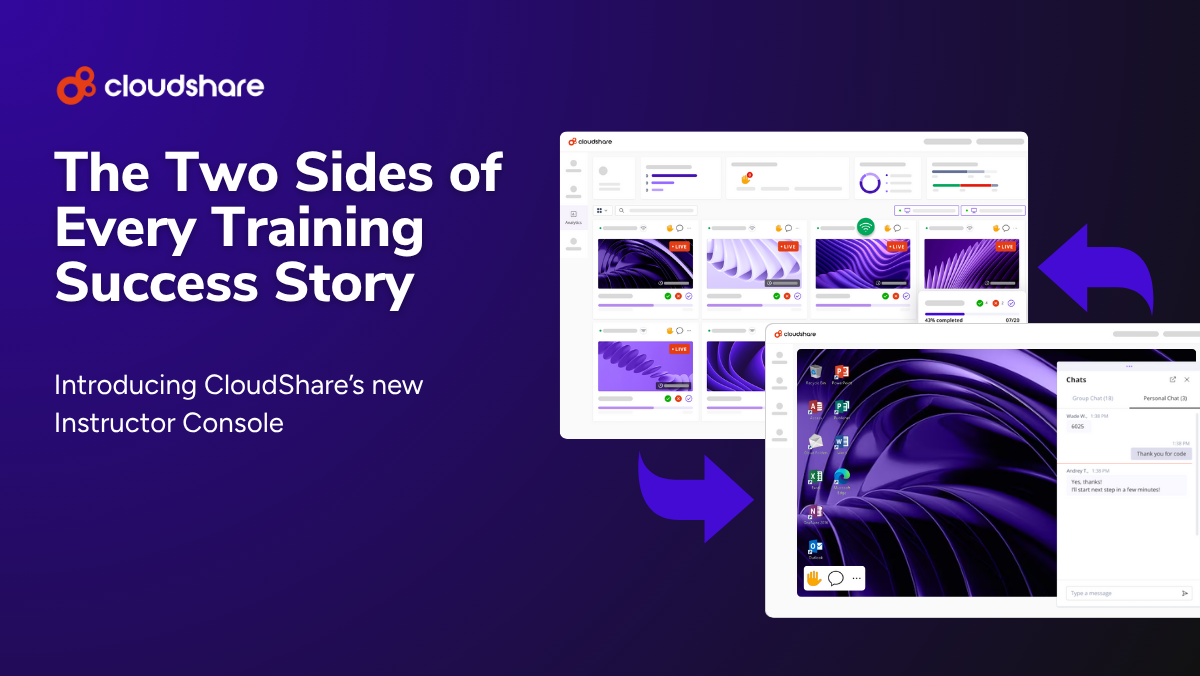
The world has changed — have your training programs changed with it?
According to 77 percent of B2B clients, technology has dramatically transformed their expectations of how companies should interact with them. For 70 percent of customers, a seamless sales, purchase and onboarding experience inspires them to purchase more. Finally, profit margins for companies with comprehensive and modernized training programs are up to 24 percent higher.
With hybrid and blended learning on the rise and in the face of an ongoing talent shortage and skill shift — it’s now more important than ever for your organization to evolve. Cloud training is an important foundation of that evolution. But what does that involve?
What is Cloud Training?
Cloud training (or cloud-based learning) is a virtual solution for traditional learning. This solution allows learners to engage with training virtually without the need to install software. The only requirement is an active internet connection.
While different vendors offer different features, cloud-based solutions typically offer a device-agnostic learning platform coupled with voice and video chat. They may also include collaborative features such as over-the-shoulder view and robust analytics to measure student performance, engagement and ROI. Finally, some cloud vendors provide customers with a sandbox environment through which participants can directly engage with lessons.
The Hidden Costs of Patchwork Solutions
You might think you can meet all the necessary requirements for supporting cloud training by deploying a video conferencing application. And maybe if your needs aren’t particularly complex, you can. Most modern video platforms and webinar applications are excellent at helping people connect online, and many offer additional functionality such as screen sharing and chat.
Infrastructure-as-a-Service solutions, meanwhile, can deliver resources anywhere in the world in just a few minutes, allowing you to support your need for scale. Just integrate a learning management solution into the mix, and you’ve got a full training stack, right? Not exactly.
Stitching this patchwork stack together will require your trainers to learn multiple systems, and prevents them from making even basic adjustments. Rightsizing hardware for class attendance, for instance, verges on impossible without a full stack solution. Moreover, this approach requires you to assess training class spend up-front, making it next to impossible to associate costs with classes.
The Many Benefits of Adopting Cloud Training
How exactly does cloud training apply to any of the stats previously mentioned?
Simply put, because it remains one of the most efficient, cost-effective delivery methods for virtual, hybrid, and blended training alike. With the right cloud training service provider and the proper best practices, your business can enjoy a wide range of benefits. These include:
- Mobility and accessibility: Instead of physical labs or meetings, cloud training can take place entirely online. Participants don’t even have to be on the same continent as one another in order to partake.
- Cost control: A cloud training service provider takes care of maintenance and equipment for your deployment. Factor in that you’ll also be spending less on maintaining a physical IT lab, and there’s significant potential for cost savings.
- Scalability: You can only seat so many people in a physical lab. Virtual labs don’t suffer from that limitation. You can scale a cloud training service to any height necessary.
- Engagement: The virtual environments enabled by a cloud training platform allow your business to provide practical, hands-on training with an ease that would be impossible in a physical environment.
- Analytics: Most training platforms feature multiple ways to track and analyze your training program — allowing you to take far greater steps when it comes to optimizing your training.
With all these benefits, it should come as no surprise that more and more organizations are embracing cloud-based technical training sessions. Cybersecurity service provider Semperis, for instance, can now configure and deploy complex virtual environments — a task which originally took hours or even days — in less than ninety seconds. Analytics and data integration specialist Qlik, meanwhile, was able to host 200 breakout sessions at a recent conference with minimal time required for preparation and configuration.
The First Step in Choosing a Full Stack Cloud Training Provider
To determine additional requirements for your cloud training lab, start by consulting with your IT department. Work with them to define your basic training and technology requirements. Once you have that nailed down, you’ll be in a better position to narrow down which cloud providers to investigate.
From there, it’s simply a matter of communicating with each vendor until you can determine which one is the best fit for your organization’s needs. Once you do, you’ll be well on your way to reaping the full benefits of virtual training.
Best Practices for Choosing a Cloud Training Vendor
In light of such advantages and gains, it should come as no surprise that demand for cloud-based training software continues to surge.
Unfortunately, that increase in demand is something of a double-edged sword. Because while there are now more options than ever for cloud training vendors, not all vendors are created equal.
To help you find your way through the jungle of options and differentiate the good from the bad, we spoke to several software and IT trainers about the virtual training best practices and success criteria that guided their decisions at each stage of the sales process.
First thing’s first, training leaders who took advantage of cloud-based training built their strategies around three core pillars:
- Delivering a complete, cloud-based training center.
- Choosing scalable, reliable cloud architecture.
- Understanding and applying cloud economics to maximize ROI.
Beyond that, the ideal cloud training vendor should also:
- Support experiential learning: People learn by doing, and experiential learning is an incredibly powerful way to improve the effectiveness of your training.
- Take a multi-cloud focus: With so many cloud providers available, you need a vendor that supports the cloud infrastructure providers you work with to ensure everything is compatible and available.
- Enable user engagement: Engaged users are far more likely to complete required training. Look for a solution provider that ties engagement into the learning process.
- Allow for scalability: Your training needs change all the time. Can your cloud training vendor scale to meet that demand? And how easily can the solution scale?
- Support automation: Setting up, deploying, and managing training environments is time consuming. Does your vendor provide automated solutions to make these processes more manageable?
- Provide detailed analytics: How will you measure the success of your training? Ensure you can turn the training data you collect into actionable insights to measure training effectiveness, ROI, and other KPIs.
Of course, these are only some of the best practices you’ll need to be on the lookout for to ensure your next cloud training vendor is the right fit.
Are you looking for the right foundation to enable your cloud training programs? See why CloudShare is the go-to partner for software companies looking to deliver hands-on training in a variety of industries.
Book a demo today to get started.



